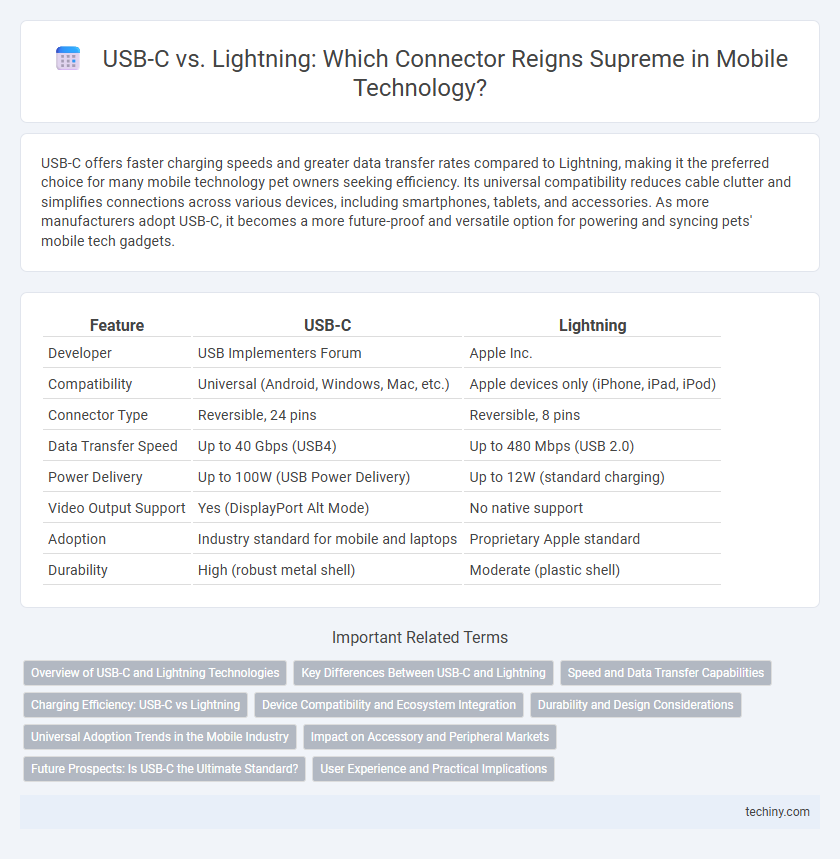USB-C offers faster charging speeds and greater data transfer rates compared to Lightning, making it the preferred choice for many mobile technology pet owners seeking efficiency. Its universal compatibility reduces cable clutter and simplifies connections across various devices, including smartphones, tablets, and accessories. As more manufacturers adopt USB-C, it becomes a more future-proof and versatile option for powering and syncing pets' mobile tech gadgets.
Table of Comparison
| Feature | USB-C | Lightning |
|---|---|---|
| Developer | USB Implementers Forum | Apple Inc. |
| Compatibility | Universal (Android, Windows, Mac, etc.) | Apple devices only (iPhone, iPad, iPod) |
| Connector Type | Reversible, 24 pins | Reversible, 8 pins |
| Data Transfer Speed | Up to 40 Gbps (USB4) | Up to 480 Mbps (USB 2.0) |
| Power Delivery | Up to 100W (USB Power Delivery) | Up to 12W (standard charging) |
| Video Output Support | Yes (DisplayPort Alt Mode) | No native support |
| Adoption | Industry standard for mobile and laptops | Proprietary Apple standard |
| Durability | High (robust metal shell) | Moderate (plastic shell) |
Overview of USB-C and Lightning Technologies
USB-C features a reversible connector supporting high-speed data transfer, video output, and power delivery up to 100 watts, making it a versatile standard for mobile devices. Lightning, developed by Apple, uses an 8-pin connector optimized for low power consumption and compact device design, primarily found in iPhones and iPads. USB-C's widespread adoption across brands contrasts with Lightning's proprietary use, influencing compatibility and accessory options.
Key Differences Between USB-C and Lightning
USB-C supports faster data transfer rates up to 10 Gbps with USB 3.1, while Lightning typically maxes out at USB 2.0 speeds of 480 Mbps. USB-C offers universal compatibility across a wide range of devices including Android smartphones, laptops, and tablets, whereas Lightning is exclusive to Apple products such as iPhones, iPads, and AirPods. The reversible design of both connectors enhances user convenience, but USB-C's ability to deliver up to 100W of power supports faster charging and broader device usage compared to Lightning's lower power delivery.
Speed and Data Transfer Capabilities
USB-C delivers significantly faster data transfer speeds, supporting USB 3.2 and Thunderbolt 3 standards with rates up to 40 Gbps, compared to Apple's Lightning connector, which maxes out at USB 2.0 speeds of 480 Mbps. The higher throughput of USB-C enables quicker file transfers, improved video streaming, and enhanced charging efficiency for mobile devices. Its universal compatibility and future-proof design make USB-C the superior choice for speed and data transfer in the evolving mobile technology landscape.
Charging Efficiency: USB-C vs Lightning
USB-C supports higher power delivery with up to 100W, enabling faster charging compared to Lightning's maximum output of around 12W for iPhones. USB-C's ability to deliver variable voltage and current enhances charging efficiency across a range of devices, optimizing battery longevity and heat management. Lightning cables, while compatible with Apple devices, lag behind in charging speed and universal adaptability offered by USB-C standards.
Device Compatibility and Ecosystem Integration
USB-C offers broad device compatibility across smartphones, tablets, laptops, and accessories from multiple manufacturers, streamlining charging and data transfer with a single cable standard. Lightning remains exclusive to Apple devices, ensuring deep ecosystem integration with optimized power delivery and seamless connectivity for iPhones, iPads, and select Apple peripherals. Choosing USB-C enhances cross-brand interoperability, while Lightning maximizes performance and accessory support within Apple's tightly controlled ecosystem.
Durability and Design Considerations
USB-C offers enhanced durability with a symmetrical connector design that withstands frequent plugging and unplugging, reducing wear and tear compared to Apple's Lightning port. The Lightning connector, while compact and reversible, uses smaller pins that are more prone to damage over time. Design considerations for USB-C include universal compatibility across devices and faster data transfer rates, whereas Lightning remains exclusive to Apple products but benefits from a slim, lightweight profile.
Universal Adoption Trends in the Mobile Industry
USB-C has become the dominant charging and data transfer standard across most mobile devices, including Android smartphones, tablets, and laptops, due to its faster data rates and universal compatibility. Lightning remains exclusive to Apple devices, but industry trends and regulatory pressures, such as the European Union's mandate for a common charging port, are accelerating the shift toward USB-C adoption. This universal adoption trend simplifies device interoperability and reduces electronic waste by standardizing cables and chargers across the mobile ecosystem.
Impact on Accessory and Peripheral Markets
USB-C's widespread adoption in mobile technology drives increased compatibility and innovation within accessory and peripheral markets, enabling seamless device interconnectivity and standardized charging solutions. In contrast, Lightning's proprietary design limits third-party accessory options, often leading to higher costs and fragmented ecosystems for consumers. The transition to USB-C fosters a more competitive market environment, encouraging manufacturers to develop versatile, cost-effective products catering to a broader range of devices.
Future Prospects: Is USB-C the Ultimate Standard?
USB-C is rapidly becoming the universal charging and data transfer standard across mobile devices due to its faster transfer speeds, higher power delivery, and widespread industry adoption. In contrast, Apple's Lightning connector remains proprietary with slower technology updates, limiting its future scalability. The increasing regulatory push in regions like the EU to mandate USB-C for all mobile devices strongly suggests USB-C will be the ultimate standardized connector.
User Experience and Practical Implications
USB-C offers faster data transfer speeds and universal compatibility across multiple devices, enhancing user convenience and reducing cable clutter. Lightning connectors remain exclusive to Apple products, providing seamless integration but limiting cross-device usability. Users benefit from USB-C's widespread adoption through easier charging options and improved accessory versatility.
USB-C vs Lightning Infographic

 techiny.com
techiny.com